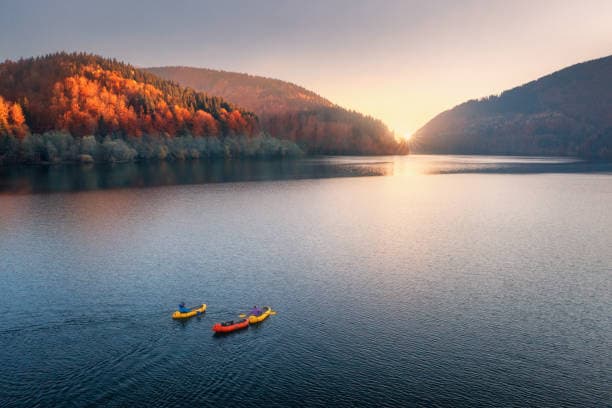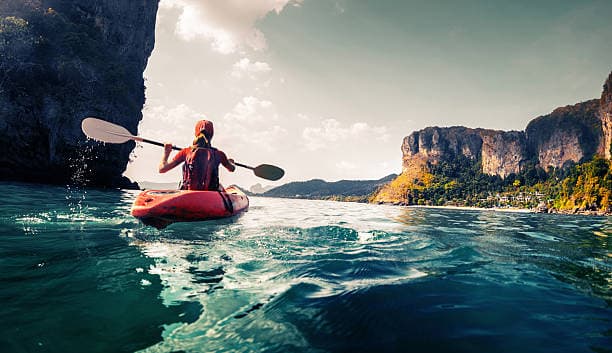How does kayaking inspire online entertainment?

Exploring calm waters and navigating unpredictable currents, kayaking offers an adventure that thrills enthusiasts and spectators alike. It is this combination of tranquility and thrill that has unexpectedly spilled over into the realm of online entertainment, inspiring a wave of creativity on various digital platforms like https://topcasinoer.net/casino-uden-rofus/. From the dynamic challenges of video games to the thrilling depths of virtual reality and the addictive richness of interactive web content, kayaking has proven to be a universal muse for the digital age. In this article, we try to find out how the principles and pleasures of kayaking have seamlessly blended into online entertainment streams, offering users around the world the chance to dive into this aquatic adventure without taking their eyes off the screen.
The Essence of Kayaking
Kayaking seamlessly blends the peacefulness of natural settings with the excitement of discovery, establishing itself as a sport cherished for both its physical demands and mental stimulation. Fundamentally, kayaking provides:
- Bonding with Nature: Kayakers find themselves deeply integrated into varied natural environments, engaging directly with wildlife and terrains that are uniquely reachable via waterways, cultivating a profound respect for the natural world.
- Discovery and Venture: Each voyage across the waterways unfolds as a fresh escapade, presenting kayakers with opportunities to uncover concealed gems of nature, ranging from isolated shores to mysterious inlets, urging them to adapt to evolving conditions and extend their boundaries.
- Physiological and Cognitive Test: The sport of kayaking requires both muscular power and stamina, alongside cognitive flexibility for effective route planning and swift choices. This dual challenge offers a comprehensive exercise regime that doubles as a meditative form of stress reduction, with the steady cadence of paddling and the bond with aquatic environments inducing tranquility.
Kayaking and Video Games
Video games inspired by kayaking merge adventure with the realism of paddling through diverse waterways. These games are crafted with attention to detail in three key areas:
Realistic Physics
Developers incorporate sophisticated water physics to simulate the dynamic interactions between the kayak and water, such as eddies, waves, and the effect of wind. This level of detail not only immerses players in a more authentic kayaking experience but also educates them on the complexities of real-world water navigation.
Diverse Environments
Beyond merely visual appeal, these virtual landscapes challenge players to adapt their paddling techniques to the environment’s specific conditions. Whether it’s moving through foggy mornings on a lake or avoiding rocks in swift river currents, each environment is designed to test and refine the player’s skills and decision-making.
Skill Development
As players progress, the game introduces more sophisticated kayaking techniques and scenarios, mirroring the continuous learning journey of actual kayaking. This includes mastering precise paddle strokes, understanding how to read river currents for efficient navigation, and learning advanced maneuvers to tackle obstacles, promoting a deep sense of achievement and skillfulness.
Virtual Reality Experiences
Kayaking becomes a vivid virtual activity thanks to virtual reality (VR) technology, closely simulating the act of paddling through diverse aquatic environments. Here’s how VR achieves this:
360-Degree Views
In addition to panoramic visuals, VR environments are meticulously designed to include ambient sounds and environmental noise, creating a full sensory experience. As they cross rapids, users may hear the surge of water, the gentle lapping of waves against the kayak in calmer waters, or the distant call of wildlife. This auditory layer complements the visual immersion, making it feel as if one is truly kayaking in a dynamically alive setting. The attention to acoustic details helps bridge the gap between virtual and real-world experiences, deeply engaging the user’s senses and enhancing the perception of being physically present within the VR kayaking environment.

Physical Interaction
The interaction within VR kayaking extends beyond visual and auditory components through sophisticated haptic feedback mechanisms in the VR controllers. This technology simulates the tactile sensations associated with kayaking, such as the feeling of water resistance against the paddle during a stroke or the impact of a wave hitting the kayak. Users can feel vibrations and changes in resistance that mimic the physical effort and finesse required in actual kayaking, from the smooth glide through calm waters to the strenuous paddling against strong currents. This not only adds a profound sense of realism but also physically engages users in a way that closely mirrors the actual sport, enhancing muscle memory and providing a form of virtual practice that can translate to improved skills in real kayaking.
Environmental Interaction
VR technology goes further to create a responsive and interactive virtual environment that reacts to the user’s presence and actions. For example, touching the virtual water can create realistic ripples and splashes, while approaching wildlife may cause them to flee or react curiously, depending on the species and scenario. Obstacles like rocks or fallen trees require precise maneuvering, and the virtual environment can adapt, changing water flow or weather conditions based on the user’s progression and interactions. This level of environmental responsiveness ensures that each VR kayaking session is unique and engaging, encouraging users to explore and interact with their surroundings actively. The dynamic interactivity fosters a deeper connection with the virtual environment, promoting a more immersive and enjoyable VR kayaking experience that blurs the lines between virtual and actual outdoor adventure.
Interactive Web Content
The realm of interactive web content has harnessed the spirit and essence of kayaking, transforming it into a rich source of both education and entertainment for enthusiasts and newcomers alike. Through an array of online platforms, users can immerse themselves in the world of kayaking, gaining knowledge, skills, and a deeper appreciation for the natural environments kayakers explore. Here’s a deeper exploration of how interactive web content brings the world of kayaking to life:
- Online Tutorials and Courses
These resources provide step-by-step guides on kayaking techniques, safety protocols, and environmental stewardship through engaging formats like videos, simulations, and quizzes. They cater to all skill levels, allowing users to progressively enhance their kayaking abilities in a structured manner.
- Interactive Maps
Digital maps enrich the planning phase of kayaking adventures by detailing routes, difficulty levels, and points of interest, alongside user-contributed reviews and photos. This tool not only aids in discovering new waterways but also fosters community interactions through shared experiences.
- Environmental Conservation
Web content also emphasizes the importance of preserving natural waterways, offering guidance on minimizing environmental impact while kayaking. It highlights conservation efforts and encourages users to participate, fostering a community committed to ecological preservation.
Conclusion
Kayaking’s influence on online entertainment is a testament to the sport’s versatility and appeal. By translating the physical and mental challenges, the connection with nature, and the spirit of adventure into digital formats, developers and content creators have opened up new avenues for experiencing the joys of kayaking. Whether through video games, virtual reality, or interactive web content, the essence of kayaking continues to inspire and engage audiences around the globe, bringing the thrill of paddling into the digital age.